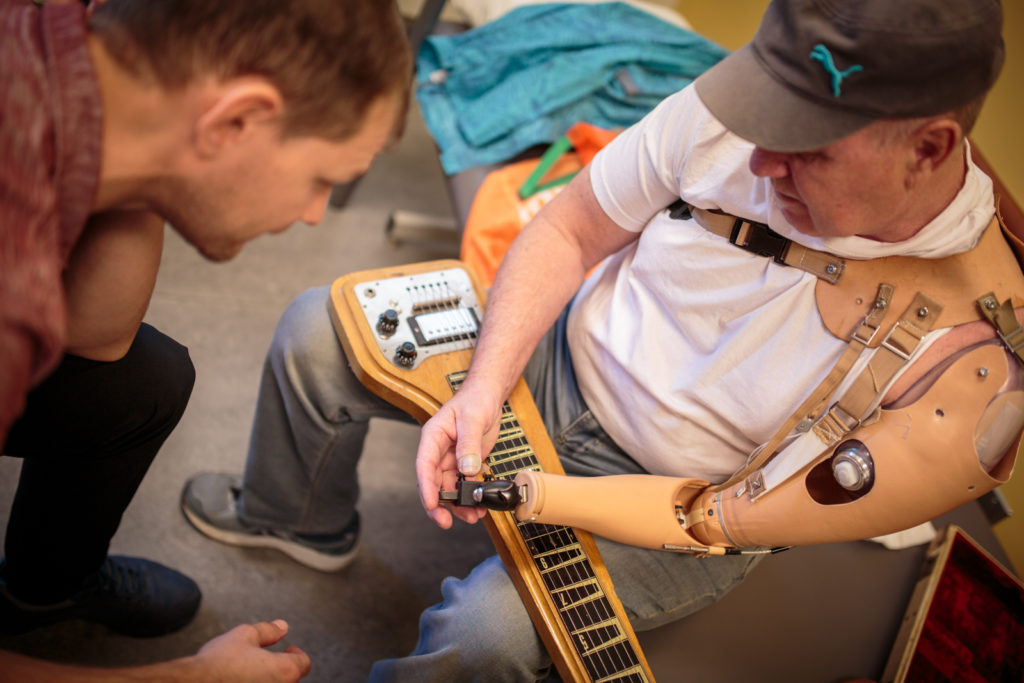A patient provides feedback on how the guitar piece is progressing and what improvements can be made to help with his specific style of playing.
Up Close: Prosthetics and Orthotics in motion
No two people are the same when it comes to prosthetics and orthotics. It’s not like wearing size 8 shoes. Each device, whether it’s an artificial limb, brace, or shoe insert, is fully customized to the patient’s body and needs. As their body or needs change, new devices are required. This often results in life-long relationships between patients, their families and our Prosthetics and Orthotics team.
Each device is created onsite at Hamilton Health Sciences by a dynamic team of creative professionals using the latest technology. These photos are just a glimpse into the work done by our Prosthetics and Orthotics team.
Close
A positive cast is being made by pouring plaster in to the negative cast. The negative cast is made from applying plaster bandages to the body.
1 of 22
Heather modifies a positive cast by adding and removing plaster to adjust shape prior to molding plastics.
2 of 22
A patient provides feedback on how the guitar piece is progressing and what improvements can be made to help with his specific style of playing.
3 of 22
A computer numerical control (CNC) machine carves out large pieces of foam that usually represent a patient’s torso. A computerized scan is used if it’s difficult to hold position for the duration of plaster drying or too large. Computerized scans are also used for children’s helmets.
4 of 22
A row of foam carvings from the CNC that will be adjusted by hand.
5 of 22
Dense foam is added to pressure points for comfort, usually bony areas. This is for a body jacket (Thoracic Lumbar Sacral Orthosis). The foam carving from the CNC machine has a “slush coat” of plaster which makes it easier to remove the plastic when it’s molded over.
6 of 22
A clinician works with a child to progress with their helmet fitment by making inner liner and adjusting for pressure points. They relieve sections of foam to help change shape of head during growth.
7 of 22
A helmet is being prepared for lamination. A vacuum sealed bag has resin sucked through the material.
8 of 22
Custom transfers and graphics can be embedded in to the resin.
9 of 22
A vacuum bag get filled with a custom pigmented resin for a below knee (trans tibia) laminate. The Nyglass (nylon and fiberglass blend) gets massaged to remove air bubbles and push in to all voids of material.
10 of 22
The partial forefoot made from cork is being reshaped by sanding off burs.
11 of 22
The leather sleeve soaked in water makes it more malleable. Then it’s beaten with anvil/hammer to form the desired shape.
12 of 22
A collection of casts at various stages of adjustment getting ready for the plastic devices to be molded.
14 of 22
Plastic parts being test fitted on to a plaster cast.
15 of 22
Holes are being melted for fasteners on hip disarticulation socket straps.
16 of 22
A clinician works with the patient on a socket adjustment. The fitting process helps adjusts for pressure points, weight distribution and alignment for metal components.
17 of 22
Each team member performs the stitching on their own projects for any fasteners, belts, straps, and leather components. Sometimes stitched by hand on heavily shaped leather pieces.
18 of 22
As machines get used, they require regular maintenance and repairs. This sewing machine was built to last and has been in use for approximately 50 years.
19 of 22
Plastic sheets get heated up in ovens and wrapped around the plaster molds. A vacuum sucks the plastic over the mold.
20 of 22
In the cutting room, the plastic molds are cut using a variety of electric and air tools as well as sanders. This piece is a wrist hand orthosis (WHO).
21 of 22
A clinician examines a patient’s walking patterns and explores what they are feeling.
22 of 22
Previous Next

